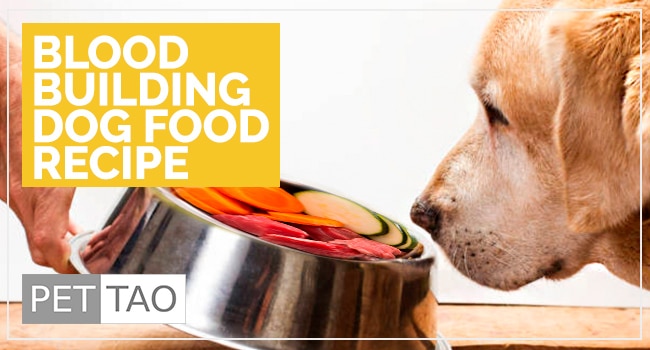Do You Need Blood Buiding Dog Food?
Why would you need blood-building dog food?
When you see the term “Blood Deficiency,” the first thing that pops into your mind is anemia, right?
Although anemia and blood deficiency aren’t the same thing, thinking this way leads you in the right direction.
What Is TCVM Blood Deficiency in a Dog?
In Traditional Chinese Veterinary Medicine (TCVM), “blood” is much more than the liquid red substance the heart pumps and travels through your veins. In TCVM, Blood nourishes and provides moisture for your dog’s entire body. It keeps your dog’s tendons, skin, and hair healthy, strong, and flexible. Blood lubricates the joints and nourishes the mind. It keeps your dog calm and ensures restful sleep.
Meet Justine, A Blood Deficient Dog
Justine is a 5-year-old, spayed female Pit Bull. She has been limping off and on for two years with bilateral cruciate tears.
She also has dandruff and a pale, dry tongue. Justine is the perfect example of a Blood-deficient dog.
The classic signs of TCVM Blood Deficiency in dogs are:
- Pulled ligament
- Cranial cruciate ligament rupture (torn ACL)
- Knee injuries
- Dandruff, dry skin, and hair
- Pale, dry tongue
- Depression, apathy, lack of spirit
- The sallow or dull coloring
- Arthritis
- Anemia
Creating the TCVM Blood-Building Diet
Use Eastern Food Therapy to rebuild your dog’s Blood.
A nutritionally balanced canine diet contains:
- 60% – 80% Protein – mostly from meat
- 20% – 40% Carbohydrates – from grains, vegetables, and fruit
- A minimum of 2% fat
Use the list of foods below to create endless delicious recipe combinations for your dog!
Mix up the ingredients as needed to create a food that your dog loves.
TCVM Blood Building Foods
Meats/Protein Source
- Beef, red meats
- Eggs
- Liver
- Oyster
- Sardine
- Seeds
- Tuna
Vegetables/Fruits
- Sea vegetables
- Beets
- Dandelion
- Carrots
- Kale
- Leafy greens
- Seaweed
- Spinach
- Spirulina
Grains/Beans/Starch
- Barley: 1 1/4 cups dry barley + 1 1/2 cups water = 1 1/2 lbs cooked barley
- Kidney beans: 1 1/2 cups dry kidney beans + 4 1/2 cups water = 1 1/2 lbs cooked kidney beans
- Oatmeal: 1 1/2 cups dry oatmeal + 3 cups water = 1 1/2 lbs oatmeal
- Brown rice: 1 1/4 cups dry brown rice + 2 1/2 cups water = 1 1/2 lbs cooked brown rice
- Whole grains: 1 1/2 cups dry whole grains + 3 3/4 cups water = 1 1/2 lbs cooked whole grains
Fats
- Nuts
- Seeds
- Olive oil
- Flaxseed oil
Sample TCVM Blood Building Dog Food Recipe
Mix and match the above lists however you want!
The basic guidelines are:
- 5 lbs from the “Meat/Protein Source” list
- 1 1/2 lbs from the “Vegetables/Fruits” list
- 1 1/2 lbs from “Grains/Beans/Starch” list
- 1 tablespoon from the “Fats” list
Sample Recipe
- 3 pounds beef, beef liver, sardines
- 1 pound chicken gizzards
- 1 pound chicken liver
- 1 1/2 lbs cooked barley
- 1 1/2 pounds carrots, green peas, spinach, broccoli
- 1 tablespoon olive oil or flaxseed oil
- 1 teaspoon parsley
- 1 teaspoon basil
Directions:
Debone and chop meat and vegetables.
Place all ingredients in crockpot layering:
- Slow-cooking root vegetables on the bottom
- Meat in the middle
- Fast-cooking items on top
Top with 1 cup of water.
Cook on low for 4 hours.
In addition, add the following to your pet’s diet:
- One canine multivitamin per day
- Calcium supplement 50mg/kg of body weight (22mg/lb of body weight) per day. Some other good choices for calcium are eggshell powder or bone meal.
Feeding Schedule:
- Feed 1.5 cups per 25 pounds of body weight twice daily
- Monitor your pet’s weight. If an undesirable weight loss occurs, please contact your veterinarian immediately so that you can make an adjustment to the feeding/diet plan.
Don’t Have Time to Cook? Order The Food Already Made
Please consult with your veterinarian and use personal judgment when cooking at home for your dog. Even though pet food recalls and the poor quality of some pet foods are a concern, many veterinarians voice concerns over homemade diets. Some vets feel that when fed exclusively, homemade diets may result in vitamin/mineral deficiencies that can adversely affect a pet’s health. If you choose to feed your dog a homemade diet, you must understand and meet your dog’s needs to stay healthy. Please share our recipe with your veterinarian. Your veterinarian can advise you on supplements for your pet’s individual situation. Monitor your dog’s health by observing his/her temperament, skin, coat, and waste. If you notice anything strange, contact your veterinarian immediately.








